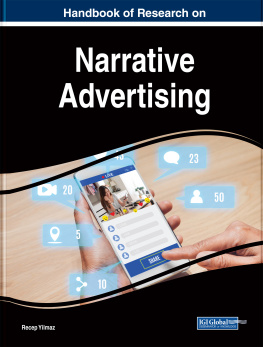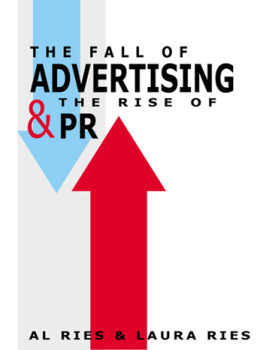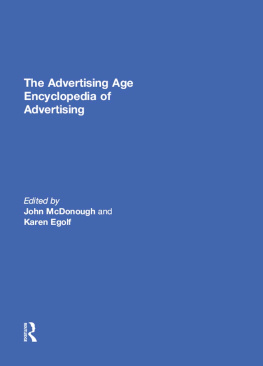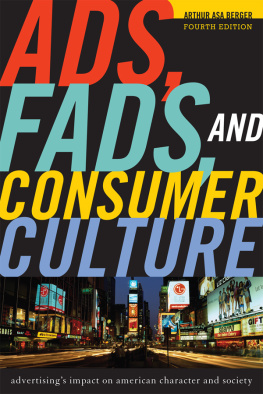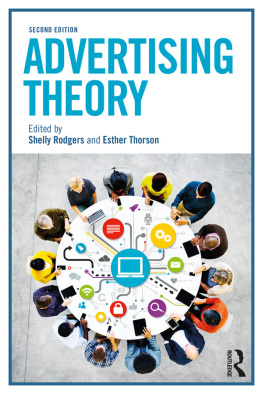Advertising
and Violence
Advertising
and Violence
Concepts and Perspectives
Nora J. Rifon
Michigan State University
Marla B. Royne
University of Memphis
and Les Carlson
University of Nebraska-Lincoln
EDITORS
With a Foreword by
Wally Snyder
Executive Director, Institute of Advertising Ethics
First published 2014 by M.E. Sharpe
Published 2015 by Routledge
2 Park Square, Milton Park, Abingdon, Oxon OX14 4RN
711 Third Avenue, New York, NY 10017, USA
Routledge is an imprint of the Taylor & Francis Group, an informa business
Copyright 2014 Taylor & Francis. All rights reserved.
No part of this book may be reprinted or reproduced or utilised in any form or byany electronic, mechanical, or other means, now known or hereafter invented,including photocopying and recording, or in any information storage or retrievalsystem, without permission in writing from the publishers.
Notices
No responsibility is assumed by the publisher for any injury and/or damage topersons or property as a matter of products liability, negligence or otherwise,or from any use of operation of any methods, products, instructions or ideascontained in the material herein.
Practitioners and researchers must always rely on their own experience andknowledge in evaluating and using any information, methods, compounds, orexperiments described herein. In using such information or methods they shouldbe mindful of their own safety and the safety of others, including parties forwhom they have a professional responsibility.
Product or corporate names may be trademarks or registered trademarks, andare used only for identification and explanation without intent to infringe.
Library of Congress Cataloging-in-Publication Data
Advertising and violence : concepts and perspectives / edited by Nora J. Rifon, Marla B. Royne, and Les Carlson. pages cm
Includes bibliographical references and index.
ISBN 978-0-7656-4268-4 (hardcover : alk. paper) ISBN 978-0-7656-4269-1 (pbk. : alk. paper)
1. AdvertisingSocial aspects. 2. Violence. 3. Violence in mass media. I. Rifon, Nora J., 1956II. Royne, Marla B., 1960 III. Carlson, Les.
HF5821.A294 2014
659.1045552dc23 |
2014010000 |
ISBN 13: 9780765642691 (pbk)
ISBN 13: 9780765642684 (hbk)
Contents
Wally Snyder
Les Carlson, Nora J. Rifon, and Marla B. Royne
Carlos Cruz and Brad J. Bushman
Hillary A. Leonard and Christy Ashley
Charles S. Gulas, Kim K. McKeage, and Marc G. Weinberger
Benjamin J. Blackford, James Gentry, Robert L. Harrison, and Les Carlson
Tom Reichert and Marc G. Weinberger
Michael L. Capella, Ronald Paul Hill, Justine M. Rapp, and Jeremy Kees
Laurence Ashworth, Martin Pyle, and Ethan Pancer
Nora J. Rifon, Karen Smreker, and Sookyong Kim
Marla B. Royne and Alexa K. Fox
E. Deanne Brocato, Douglas A. Gentile, Russell N. Laczniak, Julia A. Maier, and Mindy Ji-Song
Karen L. Becker-Olsen and Patricia A. Norberg
Magdalena Cismaru, Gitte Jensen, and Anne M. Lavack
Sarah N. Keller, Timothy Wilkinson, and A.J. Otjen
Leleah Fernandez and Jef I. Richards
Tim Jones, Peggy H. Cunningham, and Katherine Gallagher

Advertising and Violence: Concepts and Perspectives, edited by Nora J. Rifon, Marla B. Royne, and Les Carlson, is an important resource for academic, government, and industry leaders. It provides the essential compendium and collection of academic research, conclusions, and recommendations on violence in advertising.
The ethical dilemmas presented by any amount of violent advertising and the possible impact it may have on children, women, and vulnerable audiences need to be addressed for the benefit of the public. This work is balanced in its treatment of advertising violence and its potential effects, and calls for a thorough vetting by academics with industry leaders. Indeed, in their introduction the editors see the book as a solid starting point for the discussion, contemplation, and elaboration that is necessary to reach appropriate and needed conclusions and recommendations that could form the basis for policy formulation as needed and/or required.
The issue for further discussion is not about the political correctness of the depiction of violence in advertising. The research findings and conclusions in the book provide a strong foundation for discussing two issues with industry leaders: (1) the communication intent and usefulness in using violent depictions and (2) the ethical dilemmas presented with violent depictions in both adult and childrens advertising. These two questions are linked, because, as the authors of contend, not all violent depictions are bad. They make the assertion that under some circumstances such depictions are justified. Whether the particular ad is ethical and responsible depends on already determined factors, including the nature of the audience, as well as the purpose of the use of violence, such as to prevent actual harm in the real world.
There is an excellent and detailed accounting in of the governments role in the regulation of violence in advertising, mostly the limitations imposed by the First Amendment to the U.S. Constitution. Basically, truthful advertising, even though violent, is protected under the First Amendment unless a real threat of the violence is proved. A California law prohibiting the sale and rental of violent video games to youth under the age of 18 was struck down by the Supreme Court. In a 72 vote, the justices ruled that the law was unconstitutional and that it violated the First Amendment rights of children. The Federal Trade Commission remains interested in violence in advertising aimed at children and holds hearings and publishes reports to Congress and the public on the self-regulatory actions of the music, film, and video-game industries.
It appears that any substantial change in the current depiction of violence in advertising will come about only through action taken voluntarily by the advertising industry on ethical considerations. Importantly, the authors of recommend an extensive ethical construct to determine the appropriateness of violence in different advertising settings. For me, an ethical approach based upon the right thing to do for the consumer is the basis of real discussions between academic, industry, and government leaders. The books research and recommendations can be helpful to the industrys ongoing self-regulatory mission, including to the Childrens Advertising Review Unit (CARU).
While president of the American Advertising Federation, I had the opportunity to serve on the board overseeing CARU. It has published guidelines relating to Inappropriate Advertising that only age appropriate videos, films and interactive software are advertised to children and that Advertising should not portray or encourage behavior inappropriate for children (e.g., violence or sexuality) or include material that could unduly frighten or provoke anxiety in children; nor should advertisers targeting children display or knowingly link pages of a website that portray such behaviors or materials.
Next page



